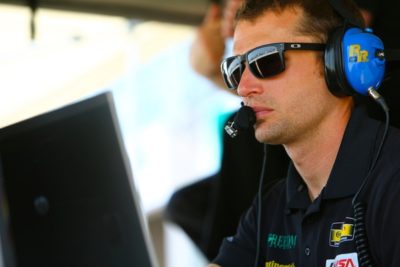A little radio communication can make a big difference in a race to drivers of all levels.
“Inside, inside…clear!”
It’s the chatter you might hear when the NASCAR broadcast picks up the spotter’s radio. It gets more complicated than that, of course, but not usually as complicated as in F1, when the drivers may be getting all sorts of engineering data along with race information.
For the average amateur road racer, little of either applies. Sure, there are times when a driver needs to know where a passing car is, but most radio conversation becomes more like basic reminders and a bit of coaching, according to Chris Long, who helped out several Mazda drivers at the SCCA National Championship Runoffs with spotting. Several of the drivers whom Long spotted for were using radios in racing for the first time.
Long is the brother of Mazda SKYACTIV Prototype driver (and often Continental Tire SportsCar Challenge ST driver) Tom Long, and the two started out together, with Tom at the wheel and Chris on the microphone.
“I think we were one of the few people that had radios back then in our open trailer days,” he says. “I would just go to a corner; I didn’t know what I was doing, but I would tell him if there was a car spinning. Then we won the Hankook Pro Spec Miata in 2005, the East championship and the National Championship. I guess the biggest step in my spotting career for me was one of his Rolex 24 Hour rides. He said, ‘They don’t have a spotter, so you’re going to be the guy.’ I just downloaded a bunch of NASCAR tapes to get the lingo right. I think I had the right words, but my timing was off.”
Now he does spotting and fuel strategy for Freedom Autosport. But many people spotting for a friend or family member are in the boat he once was, not really knowing exactly how spotting is supposed to work. Chris has some advice for those just starting out.
“It starts on the pace lap with some simple reminders. Are the belts tight? Let’s start to pair up here. Start thinking about a restart here. Nice, smooth shifts. I’ll call the flag, call traffic – whether it be inside or outside. As the cars start to string out, then we’ll start looking at gaps to cars front and back. And, of course, if a car spun in the middle of the track on the exit and it’s blind – like Turn 1 [at Daytona], if a car spins in T2.
“Then it’s counting down laps, keeping the driver situationally aware. If there’s nothing to be gained front or back, there’s no need to push the car. But it you’ve got a competitor catching…you’ve just got to be aware in the race.”
Having a spotter can be surprisingly beneficial, and actually make some drivers faster. Long tells a story of one driver he spotted for at the Runoffs.
“One of the good stories was Cherie Storms in B-Spec,” Long says. “Her goal was modest: she didn’t want to finish last. She lost the pack, and we worked on her line a little bit. She came back, three-quarters of a second better. She walked the guy in front down and passed him with three laps to go. She came out of the Bus Stop with a gap of five to eight car lengths, and it was a side-by-side finish.”
It’s one story of how spotting can be beneficial, even to the club racer. Look for a feature in the near future for some tips on how a driver can make good use of a spotter.


 ACCESSIBILITY
ACCESSIBILITY